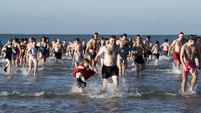Sub zero search for survivors after Iran quake kills more than 400
Survivors frantically searched for loved ones in sub zero temperatures tonight after a powerful earthquake flattened villages in the mountains of central Iran, killing at least 420 people and injuring more than 900.
The magnitude 6.4 quake struck the region shortly before dawn, damaging at least 40 villages with a population of 30,000 people, officials said.
Iranian television showed survivors slapping their faces in grief as they sat next to bodies of loved ones, wrapped in blankets.
“Where have you gone. I had a lot of plans for you,” Hossein Golestani sang softly to his lifeless seven-year-old daughter, held in his arms. Another dead daughter, an eight-year-old, lay beside him.
A heavy rain hampered rescue efforts, and as night fell and temperatures got colder, snow began to fall in some villages. Survivors huddled around fires to keep warm, covering themselves with blankets and sipping soup.
Emergency officials tried to evacuate survivors to nearby towns and cities, and some 1,500 workers from the Iranian Red Crescent, along with sniffer dogs and mountain rescue teams, fanned out with tents and tarps to the effected villages.
But the agency told international relief officials it did not need outside aid, said Roy Probert, a spokesman for the Geneva-based International Federation of Red Cross and Red Crescent Societies.
Iranian relief officials said they were benefiting from their experience in the far more devastating earthquake that hit about 150 miles away in Bam in December 2003, killing 26,000 people and flattening the historic city.
While homes made of mud collapsed in today’s quake, cement buildings appeared not to have sustained heavy damage. The destruction was limited by the region’s sparse population.
Still, the tiny villages that dot the mountain ranges were heavily hit. In Sarbagh, nearly 80% of the houses were destroyed.
The quake was centred on the outskirts of Zarand, a town of about 15,000 people in Kerman province 600 miles south-east of the capital Tehran,.
Provincial officials in the province saying the death toll had surpassed 400.
Interior Ministry spokesman Jahanbakhsh Khanjani said 380 people had been killed and more than 760 injured. There was no immediate explanation for the varying numbers.
Television footage showed a village almost flattened with few mud-brick walls still standing.
Residents could be seen digging frantically amid collapsed slabs of concrete and piles of dirt in a bid to find people buried under the rubble.
Victims wrapped in bloodied bandages or with broken legs and hands were shown in a local hospital.
“All hospitals in Zarand are filled to capacity with the injured. Hospitals in the town cannot receive any more of the injured,” the broadcast said, showing images of elderly women and men lying on beds with various injuries.
The governor of Zarand as saying that power in the region had been disrupted. He said supplies were needed, especially medicine, syringes and tents.
A spokesman for the governor, Mostafa Soltani, said the experience of the Bam quake helped local authorities cope with the situation.
“The earthquake in 2003 gave us a very good experience of how to deal with such a natural disaster. Despite the rain, relief operations are going smoothly. Relief teams have reached the villages and are helping the survivors,” he said.
Iran is located on seismic fault lines and is prone to earthquakes. It experiences at least one slight earthquake every day on average.














